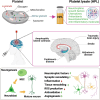Can the administration of platelet lysates to the brain help treat neurological disorders?
- PMID: 35750991
- PMCID: PMC9243829
- DOI: 10.1007/s00018-022-04397-w
Can the administration of platelet lysates to the brain help treat neurological disorders?
Abstract
Neurodegenerative disorders of the central nervous system (CNS) and brain traumatic insults are characterized by complex overlapping pathophysiological alterations encompassing neuroinflammation, alterations of synaptic functions, oxidative stress, and progressive neurodegeneration that eventually lead to irreversible motor and cognitive dysfunctions. A single pharmacological approach is unlikely to provide a complementary set of molecular therapeutic actions suitable to resolve these complex pathologies. Recent preclinical data are providing evidence-based scientific rationales to support biotherapies based on administering neurotrophic factors and extracellular vesicles present in the lysates of human platelets collected from healthy donors to the brain. Here, we present the most recent findings on the composition of the platelet proteome that can activate complementary signaling pathways in vivo to trigger neuroprotection, synapse protection, anti-inflammation, antioxidation, and neurorestoration. We also report experimental data where the administration of human platelet lysates (HPL) was safe and resulted in beneficial neuroprotective effects in established rodent models of neurodegenerative diseases such as Parkinson's disease, Alzheimer's disease, traumatic brain injury, and stroke. Platelet-based biotherapies, prepared from collected platelet concentrates (PC), are emerging as a novel pragmatic and accessible translational therapeutic strategy for treating neurological diseases. Based on this assumption, we further elaborated on various clinical, manufacturing, and regulatory issues that need to be addressed to ensure the ethical supply, quality, and safety of HPL preparations for treating neurodegenerative and traumatic pathologies of the CNS. HPL made from PC may become a unique approach for scientifically based treatments of neurological disorders readily accessible in low-, middle-, and high-income countries.
Keywords: Brain; Extracellular vesicles; Growth factors; Neuroprotection; Neurorestoration; Platelet neurotrophins.
© 2022. The Author(s), under exclusive licence to Springer Nature Switzerland AG.
Conflict of interest statement
TB is named as one of the inventors of patents applications by his academic institution, and is a founder of Invenis Biotherapies a start-up from University of Lille and Taipei Medical University.
Figures


References
Publication types
MeSH terms
Substances
Grants and funding
LinkOut - more resources
Full Text Sources
Medical
Research Materials

